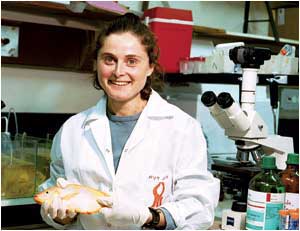
WHILE OCEAN FISHERIES ARE declining, fish farming is booming and now accounts for more than 25 percent of the fish consumed worldwide. Global aquaculture production more than doubled in the last 15 years, and the nutritional benefits of seafood will likely spur even greater expansion.
Sea cages and coastal farms generate the bulk of aquaculture’s yield, and these operations are under attack because of their adverse effect on wild fisheries. Disease and parasites from the farms breech the farms’ barriers and infect native stocks, and 10 million tons of the wild fish harvested each year become fishmeal for fish-farm operations.
One solution is inland fish farms that rely on manmade pools or earthen ponds. The 1.3 million lbs. of bass, tilapia and other fish being farmed in the Arizona desert testifies to the viability of this option. Even greater volumes are being produced in the Negev desert in Israel, where 600 tons of shrimp, tilapia and other edible species are being raised and processed. Farmers need a strong support network to prevent bacteria and viruses from wiping out these operations. To minimize downstream contamination from antibiotics in water that later is dumped from the ponds, researchers from the Ben Gurion University of the Negev’s J. Blaustein Institute for Desert Research are experimenting with natural substances to control bacteria. Among them is Dr. Dina Zilberg.
A 1998 graduate of Auburn University with a Ph.D. from the Department of Pathobiology in the School of Veterinary Medicine, Zilberg works with aquaculture operations in the Negev, visiting the farms and dealing with outbreaks of disease. Food Engineering recently spoke with Zilberg from her home in the Negev.

Zilberg: I work routinely with five farms spread over an area of 25,000 kilometers. Three of them raise food fish, including shrimp, red Australian lobster, tilapia, carp and stripped bass. Before the local aquatic health service was established, if a problem arose, affected fish would be sent to a central lab to be examined and diagnosed, and that took time. For the most part, farmers lived with the losses that resulted when diagnosis was not done as early as possible. Bacteria and parasites can affect significant percentages of the stock, particularly over time, and viral diseases can result in the entire stock being exterminated.
Besides disease, water quality is a critical factor, and you really can’t separate one from the other. The water here comes from aquifers 800 meters deep (about half a mile). There aren’t any pathogens in the water that is brought to the farm, but sulfides, which are toxic to fish in very low concentrations, are a problem. There’s also a bit of salt in the water, and a little bit of salt is good.
FE: Describe the farms’ physical layout.
Zilberg: There are 10 to 40 pools per farm, ranging from 300 to 1,500 cubic meters each. The ponds are not huge, but the number of fish can be quite intensive. Most ponds are concrete. Some have extensive biofiltration systems.
FE: Given the farms’ desert location, how liberally can water be discharged?
Zilberg: Water is costly, so they try to exchange the least amount of water possible, typically about 5 percent a day. The amount of saline water for use is unlimited, but it costs about 17 cents per cubic meter to remove it from the aquifer. One farm is surrounded by olive trees, where discharged water goes for irrigation. There are nutrients in the water from the fish, and two of the farms channel spent water to adjacent agricultural crops. Using the water for irrigation avoids environmental concerns. The Mashabei Sade kibbutz first uses the water in shrimp tanks, then discharges it as-is to melons and other crops that handle the salt well.
FE: What is the rationale for using natural medicines instead of antibiotics for fish?
Zilberg: Traditionally, large quantities of antibiotics have been used. That leads to problems of resistance to the antibiotics in the animals and the transfer of that resistance to human pathogens. A recent report suggests that a human cholera epidemic in Ecuador involving antibiotic-resistant bacteria could be traced back to aquaculture antibiotics.
Bacteria exchange genes, and that is how a disease affecting livestock can be transferred to bacteria affecting humans. A bacterium that is resistant to antibiotics could be in a fish pond and then spread to water that people come in contact with. It then cross breeds with bacteria that affect human health, and a new antibiotic-resistant super bug results.
FE: What natural medicines are you assessing?
Zilberg: Prof. Avi Golan-Goldhirsh and Dr. Rivka Ofir have amassed a library of hundreds of extracts of desert plants with potential as natural bactericidal materials. We screened about 300 of them in petri dish experiments against bacterial pathogens. Extracts from the mastic tree, wormwood, rosemary and asteriscus were shown to be very effective in retarding bacteria that attack fish and shrimp. Prof. David Mirelman from the Weizmann Institute of Science supplied me with allicin, the active compound in garlic, and it’s also proven to be a potent anti-bacterial agent.
It needs to be remembered that, except for allicin, we are using the whole plant material. When we know what the active ingredients are and their concentrations in the extract, we’ll be able to more fully answer questions regarding effectiveness.
FE: What prompted the tests involving garlic?
Zilberg: Historically it’s been known that garlic is very good for you, so it was suspected to have antibacterial properties. A group at the Weizmann Institute of Science developed a method to produce allicin, and has been supplying me with it so I could look at applications with fish in the lab.
Published articles had suggested that simply throwing cloves of garlic into the pond was helpful in promoting healthy stocks, and preliminary results from the application of allicin to fish bacteria in the lab are encouraging.
FE: At what stage is the research on natural extracts?
Zilberg: It would be very fair to characterize this field of research as being at its infancy. I’ve been working on this project in my lab for a year, and there is very little literature in the field from other places in the world. At this point, allicin looks like the most effective.
With allicin, we are working with a pure compound, while the extracts are a mixture of natural compounds obtained by solvent extraction from desert plants. We are now analyzing these extracts to identify their active compounds. When we know that, it will be easier to compare them to allicin.
The most important bacterial pathogen in fish here is Streptococcus iniae, which causes a disease in tilapia. There have been few problems with shrimp, and when infections occur, it usually involves a species of Vibrio.
FE: Besides lowering the risk of super bugs from discharged water, what other benefits are there in using natural bactericides?
Zilberg: It will be much healthier for consumers to eat fish with residues of garlic in them than to eat fish with residues of antibiotics in them. A switch to natural substances could help operators position themselves as “organic” fish farmers, which could increase demand for their products and also result in a higher market value.
FE: What are the implications of your work to desert fish farms in other parts of the world, such as Arizona?
Zilberg: I have talked with some of my counterparts there about research collaborations. There also are people in Australia who are pursuing organic aquaculture, so a global network of researchers is emerging.
Conditions in Arizona are very similar to those we have in the Negev. In Tucson, diseases affecting shrimp were some of the most difficult problems they faced. They have the best aquaculture research lab in the world there, so collaboration would be very worthwhile.
